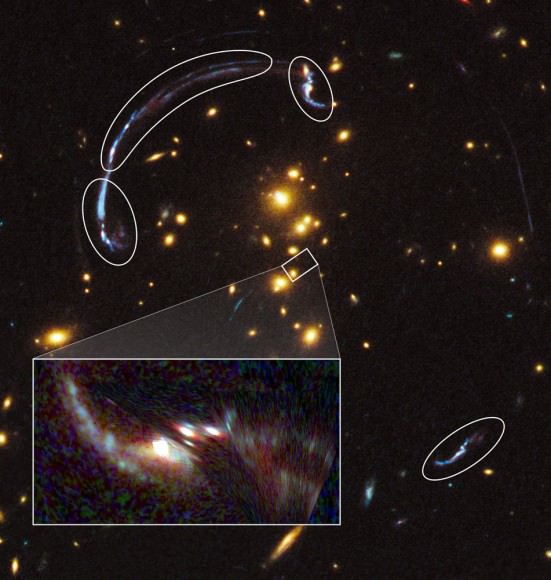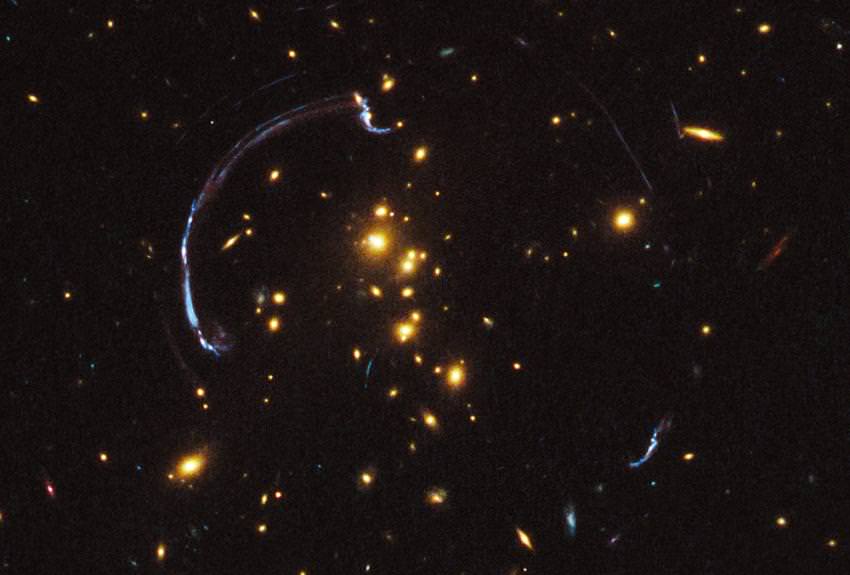[/caption]
Less than a year ago, the Hubble Space Telescope’s Wide Field Camera 3 captured an amazing image – a giant lensed galaxy arc. Gravitational lensing produces a natural “zoom” to observations and this is a look at one of the brightest distant galaxies so far known. Located some 10 billion light years away, the galaxy has been magnified as a nearly 90-degree arc of light against the galaxy cluster RCS2 032727-132623 – which is only half the distance. In this unusual case, the background galaxy is over three times brighter than typically lensed galaxies… and a unique look back in time as to what a powerful star-forming galaxy looked like when the Universe was only about one third its present age.
A team of astronomers led by Jane Rigby of NASA’s Goddard Space Flight Center in Greenbelt, Maryland are the parties responsible for this incredible look back into time. It is one of the most detailed looks at an incredibly distant object to date and their results have been accepted for publication in The Astrophysical Journal, in a paper led by Keren Sharon of the Kavli Institute for Cosmological Physics at the University of Chicago. Professor Michael Gladders and graduate student Eva Wuyts of the University of Chicago were also key team members.
“The presence of the lens helps show how galaxies evolved from 10 billion years ago to today. While nearby galaxies are fully mature and are at the tail end of their star-formation histories, distant galaxies tell us about the universe’s formative years. The light from those early events is just now arriving at Earth.” says the team. “Very distant galaxies are not only faint but also appear small on the sky. Astronomers would like to see how star formation progressed deep within these galaxies. Such details would be beyond the reach of Hubble’s vision were it not for the magnification made possible by gravity in the intervening lens region.”

But the Hubble isn’t the only eye on the sky examining this phenomenon. A little over 10 years ago a team of astronomers using the Very Large Telescope in Chile also measured and examined the arc and reported the distant galaxy seems to be more than three times brighter than those previously discovered. However, there’s more to the picture than meets the eye. Original images show the magnified galaxy as hugely distorted and it shows itself more than once in the foreground lensing cluster. The challenge was to create a image that was “true to life” and thanks to Hubble’s resolution capabilities, the team was able to remove the distortions from the equation. In this image they found several incredibly bright star-forming regions and through the use of spectroscopy, they hope to better understand them.
Original Story Source: Hubble News Release.


The lensed galaxy appears to be two interacting galaxies. This imaging and stretching of the image is an example of how transverse modes of a string are distributed across the horizon of a black hole,
LC
Very nice description LC!
Here’s the actual (PDF) paper with pretty pictures: Source Plane Reconstruction of The Bright Lensed Galaxy RCSGA 032727-132609.
“very unique” … come on! does writing error have to be explained? 🙂